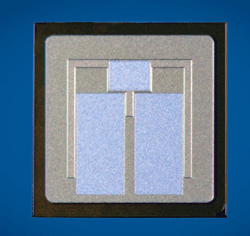- News
8 December 2011
Cree launches first fully qualified SiC MOSFETs in chip form to enable more efficient power electronic modules
 Cree Inc of Durham, NC, USA has launched what it claims is the first fully qualified silicon carbide (SiC) MOSFET power devices in ‘bare die’ or chip form for use in power electronics modules. The firm’s SiC Z-FET MOSFETs and diodes can be used in power electronics circuits to achieve significantly higher levels of energy efficiency than is possible with conventional silicon devices.
Cree Inc of Durham, NC, USA has launched what it claims is the first fully qualified silicon carbide (SiC) MOSFET power devices in ‘bare die’ or chip form for use in power electronics modules. The firm’s SiC Z-FET MOSFETs and diodes can be used in power electronics circuits to achieve significantly higher levels of energy efficiency than is possible with conventional silicon devices.
Power modules typically combine a number of discrete power switching devices (MOSFETs and diodes) in a single integrated package for high-voltage power electronics applications such as three-phase industrial power supplies, telecom power systems, and power inverters for solar and wind energy systems. In traditional MOSFET packaging technologies, the parasitic inductance of the long leads can limit the switching capability of SiC MOSFETs. By offering bare die alternatives, circuit designers can now take full advantage of the switching performance of SiC technology by reducing the effects of the package-parasitic inductance, says Cree.
“With the availability of fully qualified SiC MOSFETs as unpackaged chips, manufacturers of power modules can realize the performance advantages of SiC devices (better high-temperature operation, higher switching frequencies and lower switching losses) without the limitations imposed by conventional plastic packaging of discrete devices,” says Cengiz Balkas, Cree’s VP & general manager, power and RF. “The design advantages of implementing SiC power devices in power electronic modules include the ability to achieve higher current and voltage ratings with fewer components, which in turn can enable maximum power density and increased reliability,” he adds.
“Power module manufacturers can now combine Cree’s 1200V SiC power MOSFET and Schottky diodes in chip form to create an ‘all-silicon carbide’ module design for ultra-high-efficiency power electronics systems,” continues Balkas. “These new modules provide the proven benefits of silicon carbide - zero reverse recovery losses, temperature-independent switching, higher frequency operation with low electromagnetic interference (EMI), and significantly higher avalanche capability - and deliver switching frequencies that are five to eight times higher compared to conventional silicon solutions,” he adds. “The higher switching frequencies enable smaller magnetic and capacitive elements, thereby shrinking overall system size, weight and cost.”
The new power MOSFET devices are initially available in two versions: the CPMF-1200-S080B measures 4.08mm x 4.08mm and is rated at 1200V/20A with a nominal on-resistance (RDS(ON) of 80mΩ; and the CPMF-1200-S160B measures 3.1mm x 3.1mm and is rated at 1200V/10A with a nominal on-resistance (RDS(ON) of 160mΩ. The operating junction temperature for both is rated at -55 deg C to +150 deg C.
The two versions of the 1200V MOSFET die are fully qualified and released for production use and available to Cree’s customers, as well as through Cree’s Power die distributor Semi Dice. Cree has published specifications and detailed design guidelines, including recommendations on die attach and bonding, to assist power module makers in the use of the new devices and optimizing their designs. In addition, Cree is offering the availability of a SiC MOSFET Model, created to help with early simulation and evaluation.
